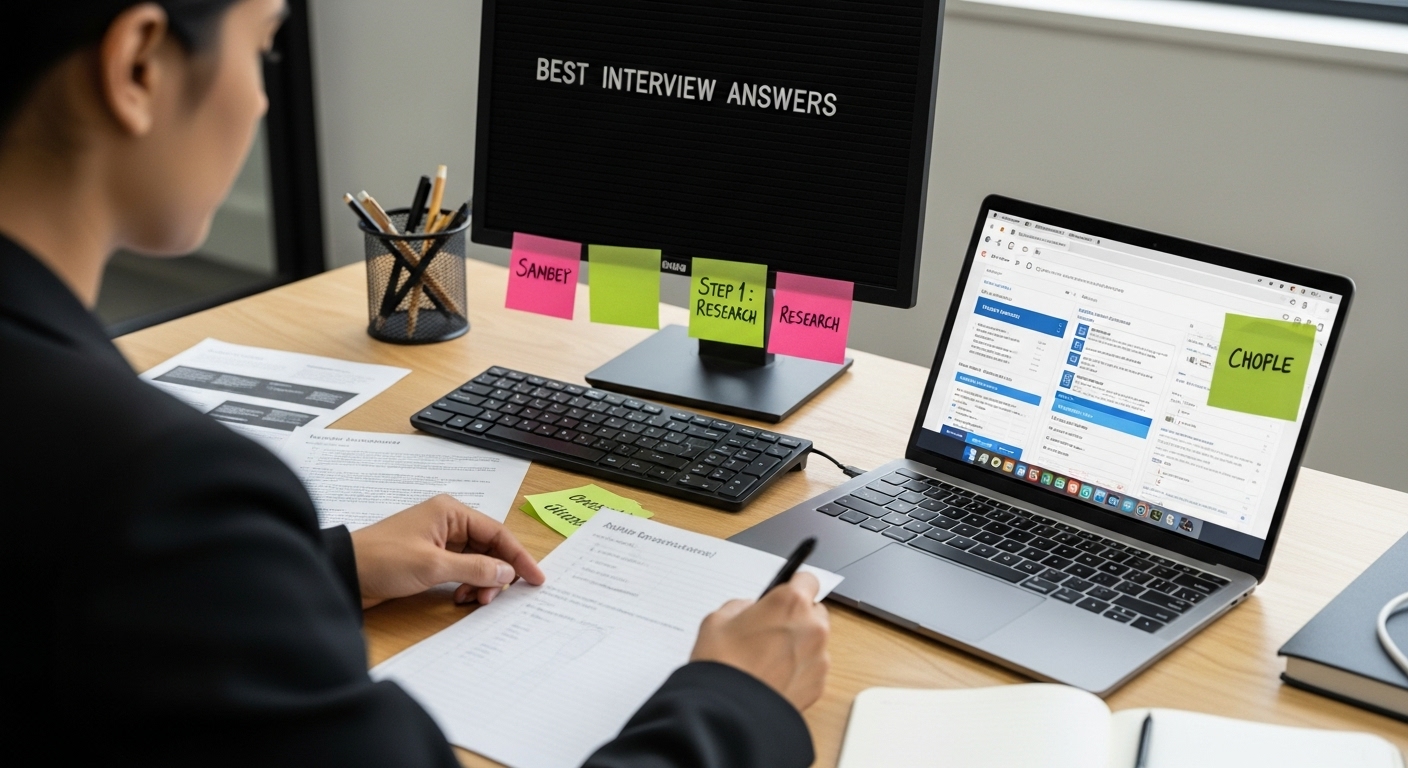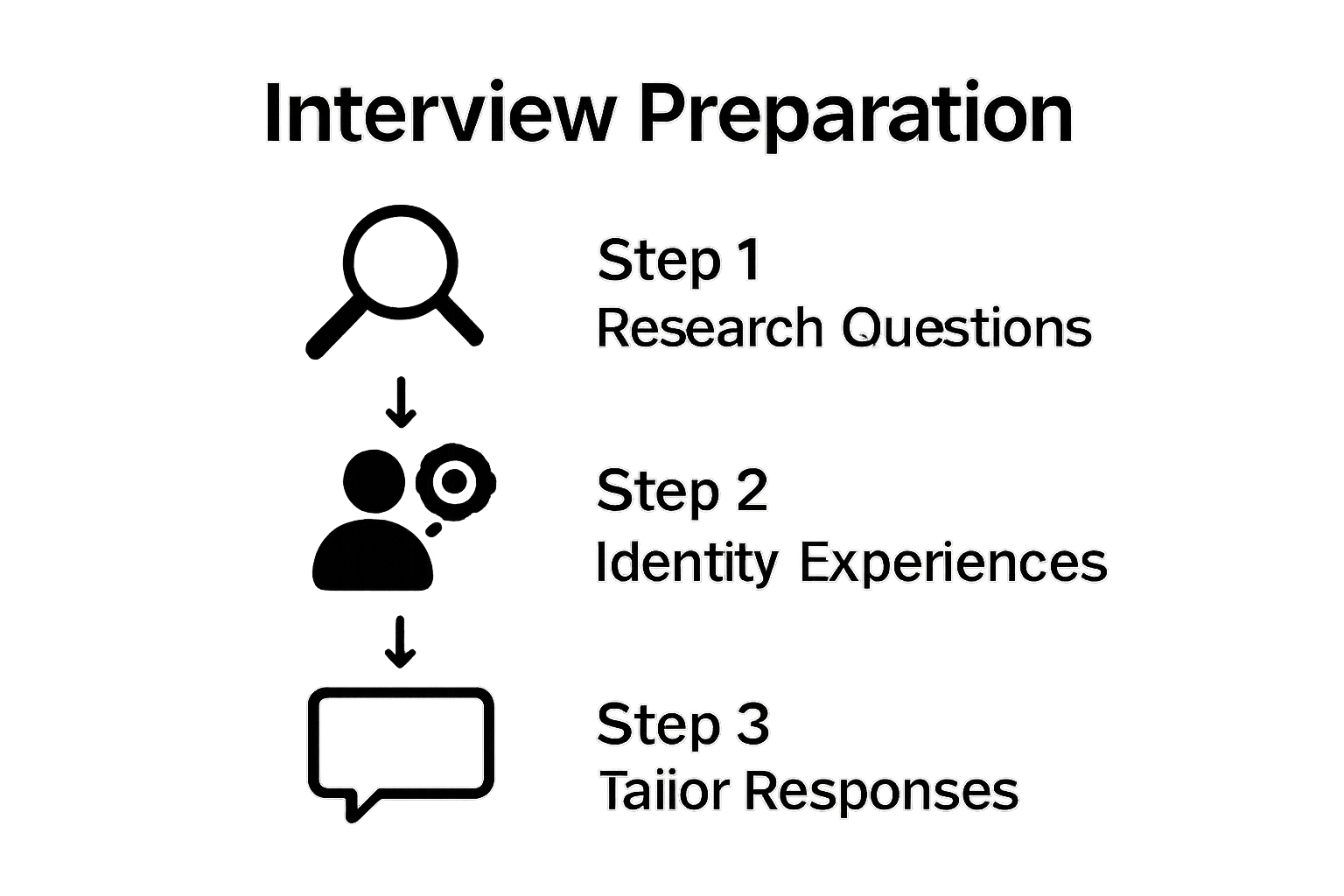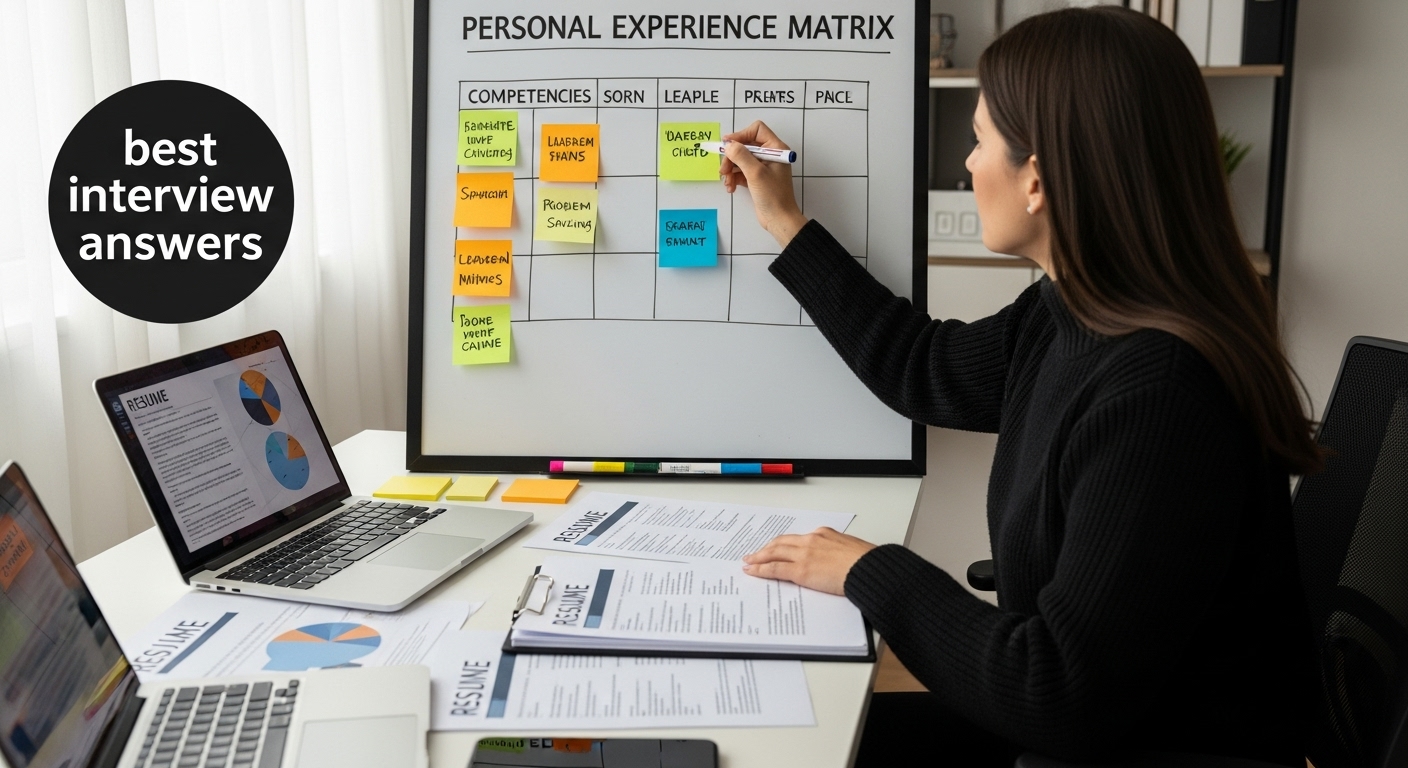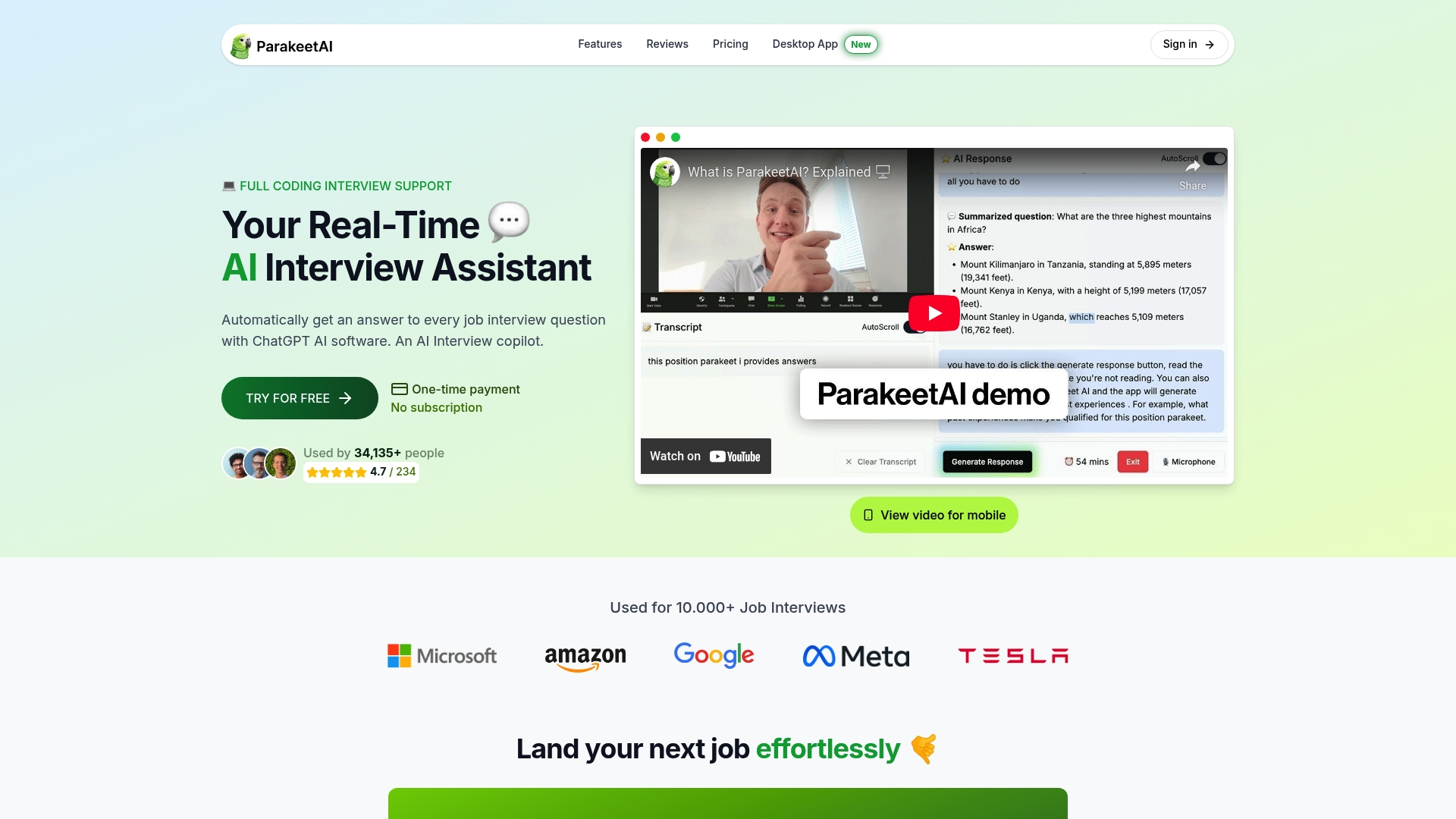Master the Best Interview Answers for Success

Preparing for a job interview can feel overwhelming when you see how many types of questions are out there. Most people try to just wing it or memorize general answers. But research shows a different path works better. Candidates who build a list of questions and draft specific, authentic answers increase their confidence and cut interview anxiety by over 40 percent. That means you do not need to be a genius interviewer. You just need the right approach—and a few strategic steps.
Table of Contents
- Step 1: Research Common Interview Questions
- Step 2: Identify Your Unique Experiences
- Step 3: Craft Tailored Responses
- Step 4: Practice Your Delivery
- Step 5: Solicit Feedback And Refine Answers
Quick Summary
| Key Point | Explanation |
|---|---|
| 1. Research common interview questions | Understand sector-specific interview styles and typical questions. Use varied sources to identify patterns and employer expectations. |
| 2. Identify your unique professional experiences | Conduct a personal audit to highlight stories showcasing your skills. Use strategic storytelling to illustrate your capabilities. |
| 3. Craft tailored responses | Create adaptable response frameworks for different questions. Balance concise communication with insightful examples relevant to potential employers. |
| 4. Practice your delivery | Enhance your communication through solo practice and mock interviews. Focus on non-verbal cues, confidence, and systematic desensitization to anxiety. |
| 5. Solicit feedback and refine answers | Build a diverse feedback network for constructive criticism. Implement improvements based on consistent feedback themes to enhance your interview performance. |
Step 1: Research Common Interview Questions
Mastering the best interview answers starts with comprehensive preparation, and the foundation of that preparation is understanding the landscape of questions you might encounter. Researching common interview questions transforms your approach from reactive to proactive, giving you a significant advantage before you even step into the interview room.
Begin your research by diving deep into industry specific and role specific interview questions. Different sectors have unique questioning styles. A tech interview will differ dramatically from a sales or healthcare interview. Start by exploring professional networking platforms like LinkedIn, career advice websites, and professional forums where people share their recent interview experiences. Look for patterns in questioning approaches that reveal what employers truly want to understand about candidates.
Utilize multiple research strategies to build a comprehensive question bank. Professional career websites, industry forums, and interview preparation resources can provide invaluable insights. Create a systematic approach by categorizing questions into fundamental types: behavioral, technical, situational, and background verification queries. This categorization helps you develop targeted preparation strategies.
Pay special attention to questions that reveal your problem solving skills, adaptability, and cultural fit. Employers are increasingly interested in understanding how you think and approach challenges, not just your technical capabilities. Questions like “Tell me about a time you overcame a significant work challenge” or “How do you handle disagreements with team members?” require nuanced, authentic responses that showcase your professional maturity.
Develop a tracking system for your research. A spreadsheet or digital document where you collect questions, draft potential answers, and refine your responses will be instrumental. Include columns for question type, potential answer framework, and personal notes about your specific experiences that might illustrate those answers effectively.
Remember that research is not about memorization but understanding. Your goal is to internalize the underlying principles of effective interviewing, not to create robotic, pre-scripted responses. Authentic preparation means being flexible, genuine, and prepared to adapt your core message to each unique interview scenario.
By the end of this research phase, you should have:
Here is a summary table that outlines the main steps to mastering the best interview answers, including each step’s focus and the intended outcome for your preparation.
| Step | Focus Area | Intended Outcome |
|---|---|---|
| 1 | Research Common Interview Questions | Build a question bank and understand interview expectations |
| 2 | Identify Unique Experiences | Create a matrix of stories that demonstrate key skills |
| 3 | Craft Tailored Responses | Develop adaptable, authentic answer frameworks |
| 4 | Practice Your Delivery | Refine verbal and nonverbal communication for confidence |
| 5 | Solicit Feedback & Refine Answers | Integrate feedback to achieve continuous improvement |
- A comprehensive list of potential interview questions across different categories
- Initial draft responses for key questions
- An understanding of your industry’s specific interview expectations
- A systematic approach to ongoing interview preparation

Step 2: Identify Your Unique Experiences
After researching common interview questions, the next critical step is identifying and articulating your unique professional narrative. This step transforms your interview preparation from generic to personally compelling, showcasing what truly sets you apart from other candidates.
Start by conducting a comprehensive personal audit of your professional journey. Pull out your resume, performance reviews, project documents, and academic records. This isn’t just about listing achievements but understanding the deeper stories behind your professional experiences. Reflect on moments where you demonstrated problem solving, leadership, adaptability, or innovation - these are the golden nuggets that interviewers seek.
Employ a strategic storytelling approach. Every professional experience contains multiple layers of insight. A project that seemed routine might reveal your ability to collaborate under pressure, manage complex timelines, or navigate interpersonal dynamics. When examining your experiences, ask yourself probing questions: What unique challenge did I solve? How did my approach differ from standard procedures? What measurable impact did my actions create?
Create a personal experience matrix that categorizes your professional stories across different competency areas. These typically include leadership, teamwork, problem solving, communication, technical skills, and adaptability. For each category, draft 2-3 specific scenarios that powerfully illustrate your capabilities. Professional career development resources recommend using the STAR method (Situation, Task, Action, Result) to structure these narratives effectively.
Technological tools can enhance your experience identification process. Use digital notebooks or career preparation apps that help you systematically document and refine your professional stories. These platforms often provide prompts and frameworks to help you extract the most compelling aspects of your experiences.
Address potential gaps or less impressive periods in your professional history constructively. Every experience, including challenges or perceived setbacks, can be framed as a learning opportunity. The key is demonstrating growth, self awareness, and a proactive approach to professional development.
By the conclusion of this step, you should have:
This checklist helps ensure your interview preparation is thorough, covering essential requirements to boost your readiness and confidence during the process.
| Preparation Task | Completion Criteria |
|---|---|
| Build a question bank | List includes industry, role, behavioral, technical questions |
| Draft key stories | 2-3 experiences for each core competency area identified |
| Prepare response outlines | Each key question mapped to a concise answer framework |
| Practice delivery | Recorded solo sessions and mock interviews completed |
| Collect feedback | Received notes from at least two professional sources |
| Revise based on feedback | Action plan for improvement documented and implemented |
- A comprehensive matrix of professional experiences across different competency areas
- 2-3 compelling stories for each major competency
- A clear understanding of your unique professional value proposition
- A narrative framework that transforms your experiences into powerful interview responses

Remember, your experiences are not just a chronological record but a dynamic narrative of your professional evolution. The goal is not to impress through volume, but to connect through authenticity and meaningful professional insights.
Step 3: Craft Tailored Responses
Crafting tailored responses represents the strategic heart of interview preparation. This step transforms your researched questions and identified experiences into precise, compelling narratives that resonate with potential employers. Your goal is not to create robotic scripts but dynamic, adaptable communication strategies that showcase your authentic professional self.
Begin by analyzing each researched interview question through a strategic lens. Each response should demonstrate not just technical competence but deeper professional insights. Develop a response template that includes a clear opening statement, specific illustrative examples, quantifiable outcomes, and a forward looking perspective that connects your past achievements to the potential employer’s future needs.
The art of tailoring responses involves understanding the subtle nuances of communication. Responses must balance conciseness with depth, providing enough detail to be credible without overwhelming the interviewer. Practice articulating your experiences in 90 second windows, which matches most interview question response expectations. This time constraint forces you to distill your experiences into their most impactful elements.
Integrate industry specific language and terminology that demonstrates your professional fluency. Research the company’s mission, recent projects, and core values to subtly align your responses with their organizational culture. Professional interview preparation platforms recommend using the company’s own language and terminology as a sophisticated mirroring technique.
Develop a flexible response framework that allows for spontaneity. While preparation is crucial, over scripting can make your answers sound mechanical. Create response outlines with key points and illustrative examples, but leave room for natural conversation and genuine interaction. Think of your prepared responses as a roadmap, not a rigid script.
Utilize technology and digital tools to refine your approach. Recording yourself practicing responses can reveal unconscious verbal tics, pacing issues, or areas where your communication could be more crisp and impactful. Many professional development apps offer AI powered feedback on communication style, helping you identify and correct potential weaknesses.
By the conclusion of this step, you should have:
- Tailored response frameworks for key interview question categories
- Practiced delivery that sounds natural and confident
- Clear examples that demonstrate your professional capabilities
- A communication strategy that adapts to different interview contexts
Remember, the most powerful interview responses are not memorized monologues but authentic narratives that reveal your professional journey. Your goal is to transform standard questions into opportunities for meaningful professional dialogue.
Step 4: Practice Your Delivery
Practicing your delivery transforms well crafted responses into powerful communication. Delivery is where preparation meets performance, turning your carefully constructed narratives into compelling professional storytelling. This step focuses on refining not just what you say, but how you say it.
Begin with solo practice sessions that build foundational confidence. Stand in front of a mirror and articulate your responses, paying close attention to your body language, facial expressions, and vocal tone. Non verbal communication carries significant weight in interviews, often conveying more than words themselves. Practice maintaining steady eye contact, controlling nervous gestures, and projecting a confident yet approachable demeanor.
Leverage technology to simulate realistic interview environments. Interview preparation platforms offer video recording tools that allow you to analyze your performance objectively. Record yourself answering questions, then review the footage critically. Look for subtle communication patterns like speaking pace, unnecessary filler words, or unconscious nervous behaviors that might undermine your professional presentation.
Engage trusted friends, colleagues, or mentors to conduct mock interviews. These practice sessions should mimic real interview conditions as closely as possible. Request specific feedback on your communication style, content clarity, and overall professional presence. A diverse group of practice interviewers can provide nuanced perspectives on how different audiences might perceive your responses.
Develop a pre interview ritual that centers and prepares you mentally. This might include breathing exercises, positive visualization, or a structured warm up routine that reduces anxiety and enhances your natural communication abilities. Professional performers and athletes use similar techniques to optimize their mental state before critical performances.
Address potential anxiety through systematic desensitization. The more you practice, the more comfortable you become with interview scenarios. Start with low stakes practice environments and gradually increase the complexity and intensity of your mock interviews. This approach helps build genuine confidence rather than superficial bravado.
By the conclusion of this step, you should have:
- Recorded multiple practice interview sessions
- Received and integrated feedback from diverse sources
- Developed a personalized pre interview mental preparation routine
- Identified and corrected potential communication weaknesses
Remember, excellent interview delivery is a skill that can be learned and refined. Consistent practice transforms nervous anticipation into confident, authentic communication. Your goal is not perfection but genuine, compelling professional self presentation.
Step 5: Solicit Feedback and Refine Answers
Soliciting targeted feedback represents the critical refinement stage of interview preparation. This step transforms your initial responses from good to exceptional by introducing external perspectives that challenge and elevate your communication strategy. Feedback is not about criticism but strategic improvement.
Build a diverse feedback network that includes professionals from multiple domains. Seek input from mentors, colleagues in your industry, career coaches, and trusted friends with strong professional backgrounds. Each perspective offers unique insights into your communication style, content clarity, and overall professional presentation. Avoid relying exclusively on people who will only offer positive reinforcement.
Create a structured feedback collection process. Provide your practice interviewers with specific evaluation criteria to guide their observations. Professional development platforms recommend creating a comprehensive feedback template that covers communication aspects like content relevance, storytelling effectiveness, non verbal communication, and overall professional impression.
Approach feedback with a growth mindset. Defensiveness blocks learning, so cultivate genuine openness to constructive criticism. When receiving feedback, listen actively without interrupting. Take detailed notes, ask clarifying questions, and resist the impulse to immediately justify or explain your current approach. The most valuable insights often emerge from moments of genuine vulnerability.
Implement a systematic approach to integrating feedback. After collecting multiple perspectives, look for consistent themes or recurring observations. These represent the most critical areas for improvement. Develop an action plan that prioritizes changes based on their potential impact on your interview performance.
Utilize technology and digital tools to supplement human feedback. Many interview preparation applications offer AI powered analysis of your responses, providing objective metrics on communication effectiveness. These tools can reveal subtle communication patterns that human reviewers might miss.
By the conclusion of this step, you should have:
- Collected comprehensive feedback from diverse professional sources
- Identified specific areas for communication improvement
- Developed a structured plan to refine your interview responses
- Created a system for ongoing professional communication development
Remember, feedback is a gift that accelerates your professional growth. The most successful professionals view every piece of constructive criticism as an opportunity to enhance their communication capabilities. Your willingness to learn and adapt distinguishes you as a candidate who is committed to continuous improvement.
Ready for Real-Time Interview Confidence?
You have just explored the core strategies for mastering interview answers. The article highlighted your biggest challenges such as preparing authentic stories, handling industry-specific questions, refining delivery, and learning from expert feedback. Even after extensive practice, the fear of forgetting what to say or getting caught off-guard can be overwhelming. You want every answer to show your unique value and you do not want anxiety to erase your preparation when it matters most.

Experience the advantage of Parakeet AI. Our real-time AI job interview assistant listens to your interview and instantly delivers tailored answers for any question, keeping your thoughts clear and your responses sharp. Practice with advanced AI interview tools to build confidence or use live assistance when the stakes are highest. Stop letting nerves hold you back. Visit https://parakeet-ai.com right now and make sure your next interview is your strongest performance yet.
Frequently Asked Questions
What are common interview questions I should prepare for?
Common interview questions vary by industry but generally include behavioral, situational, and technical questions. Research specific interview questions relevant to your field and role to gain an understanding of what employers may ask.
How can I identify my unique experiences for interviews?
Conduct a personal audit of your professional journey, analyzing your resume and recalling key projects. Focus on moments that highlight your problem-solving skills, leadership, adaptability, and innovation to identify compelling stories.
What is the STAR method and how can it help in interviews?
The STAR method stands for Situation, Task, Action, and Result. It’s a structured approach to answering behavioral interview questions by outlining your experiences clearly, making it easier for interviewers to understand your thought process and outcomes.
How can I practice my delivery effectively before an interview?
Practice your delivery by conducting solo sessions, recording your responses, and engaging in mock interviews with friends or mentors. Focus on refining your body language, vocal tone, and overall professional presence for impactful communication.




